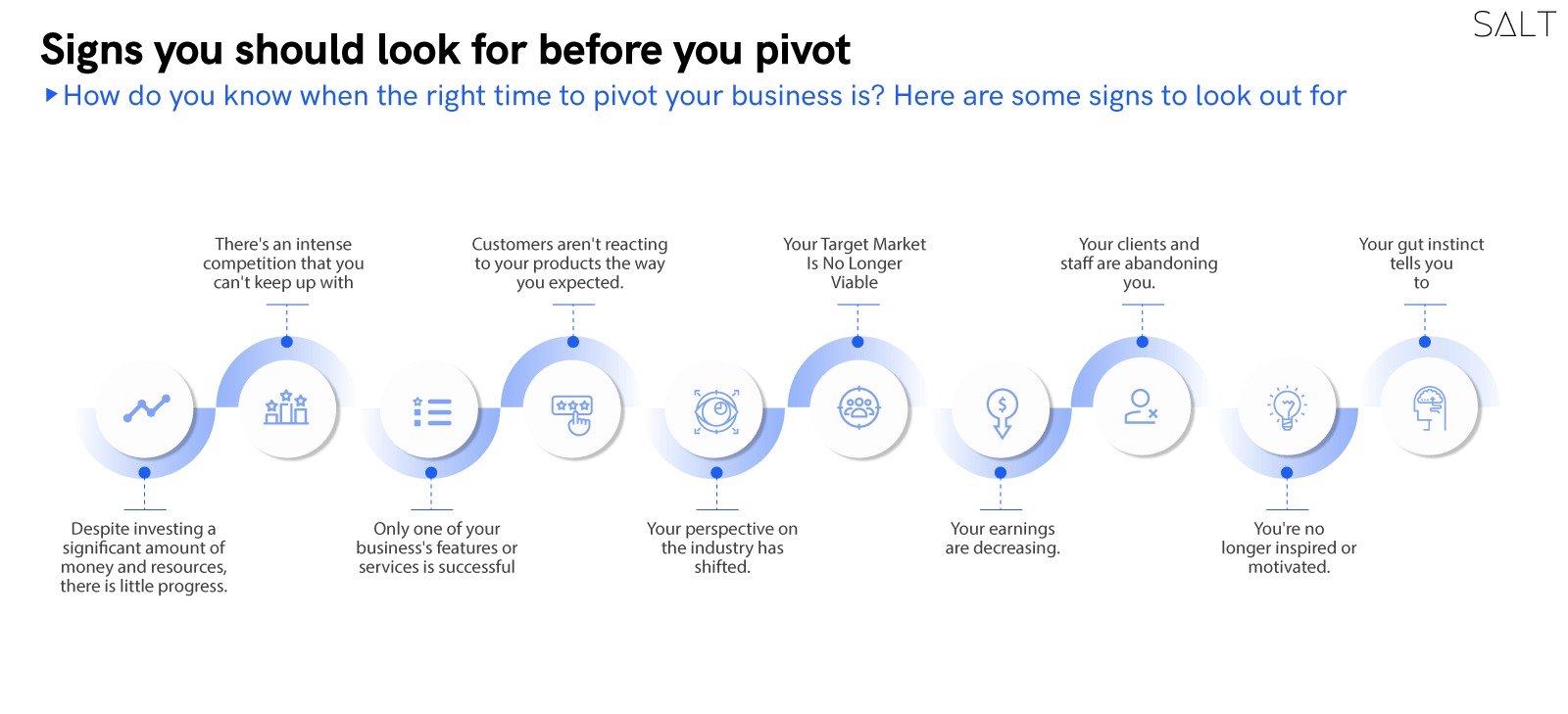Modifications and alterations are an inevitable part of running any business. Companies should continuously seek to streamline sales funnels, decrease costs, and better understand their consumers' demands to be successful. However, in some situations, such as the Covid-19 pandemic, which sent economies around the world into chaos, businesses require more than minor adjustments to stay afloat. This is where pivoting comes in.

Pivoting typically refers to any large-scale adjustment to your core business in order to boost income, drastically reduce expenses, or respond to market opportunities. No doubt, we’ve all heard about companies that became hugely successful as a result of a proactive pivot. But is pivot really necessary? When should companies pivot, and how should they do it? Here’s all you need to know.

Signs you should look for before startup pivot
How do you know when the right time to pivot your business is? Here are some signs to look out for :
- Despite investing a significant amount of money and resources, there is little progress.
- There's an intense competition that you can't keep up with
- Only one of your business's features or services is successful
- Customers aren't reacting to your products the way you expected.
- Your perspective on the industry has shifted.
- Your Target Market Is No Longer Viable
- Your earnings are decreasing.
- Your clients and staff are abandoning you.
- You're no longer inspired or motivated.
- Your gut instinct tells you to.
The 3 Dos and Donts of a Successful Pivot
The Dos
1. Listen to customers
Companies often fail because they offer a product or service that customers no longer need. It is crucial to ensure your current customers are on board when developing new offerings. To achieve this, listen to your current customers before you act.
Reverse engineering from a customer's perspective has several potential benefits. If customers have been invited to provide initial input and the product has been developed accordingly, you ensure a pre-existing sales channel once the product is released. Furthermore, current customers can be used as ready-made case studies when introducing the new offering, thereby providing third-party validation for potential customers.
There are thousands of companies scrambling to make changes right now, and those in your industry are most likely doing the same. Before pivoting, examine what your direct competitors are doing and how you can improve. Examine what other companies are doing and see if you can replicate their success with new products, services, or solutions. You may not be able to achieve significant results if you plan to offer the same items or services as your competitors.
Likewise, assess the size of your competition and whether your startup can compete with them. If a business strategy works for someone else in your field, it might work for you as well.
2. Strategise before making a move
Pivoting is an excellent way to expand your customer base and win consumer loyalty. However, if not done correctly, a pivot might result in the loss of loyal clients. As a result, growing and developing a company demands a well-thought-out strategy and a well-defined methodology.
The best way to pivot a business successfully is to rely on your strengths and core competencies. Before implementing a pivot, test your product, and devise a pivoting strategy that aligns with your core departments. You should also make sure everyone in your organisation is aware of and on board with the pivot before making any major changes.
The Donts
1. Avoiding trends
A pivot can be extremely beneficial for a startup that has hit a snag and is unable to move forward. On the other hand, if you decide to pivot your firm on a new path with little consideration for where it will go next, you're likely to hit another hurdle, albeit under different circumstances.
To avoid this, you must take advantage of current trends. New technologies are always being developed, so why not take advantage of them? Technology trends generally evolve in tandem with changing consumer wants and behaviour, and failing to adapt could result in your own customers being lured away by more innovative competitors.
2. Not leveraging existing resources
Sometimes the only change a company might need is to drive innovation by taking its existing products and services and targeting a new consumer segment or market. The company should thoroughly examine what consumers require most at a specific point in time and how they may meet that demand using existing resources. While you may need to modify resources to accommodate a new scenario, this allows you to take advantage of your current capabilities and solutions while also solving new challenges.
3. Not having a proper reason for pivoting
With so many companies pivoting and achieving huge success, it's easy for naive founders to think pivoting is the magic pill that solves all their problems. In reality, pivoting should be considered only when absolutely essential and all other options have been exhausted.
The truth is that every startup faces significant challenges on its way to success. When things get rough, businesses should ask themselves, "Can this problem be handled with further research, customer development, money, or other means?". If the answer is "no," that’s when you should consider pivoting.
Startups that pivoted gracefully
Looking to get inspired by the success stories of companies that made it? Here are two famous startups that pivoted gracefully.
- Netflix
Netflix is an excellent example of how to pivot successfully. In the modern-day, Netflix has become synonymous with binge-watching entire seasons of original Netflix series. Viewers, however, tend to forget that Netflix used to be the service that delivered DVDs to your mailbox. Founded by Marc Randolph and Reed Hastings, Netflix began as a video renting service in August 1997. Users could order movies on the Netflix website and have them delivered to their doors.
At the time, Netflix's business model competed directly with traditional movie rental establishments. In 2007, After YouTube demonstrated that streaming video was technologically ready, Netflix launched its streaming service. And the rest, as we know, is history.
Instagram is now one of the most widely used social networking sites. The image-and video-sharing service, which is owned by Meta (formerly Facebook), is worth an estimated $100 billion and boasts of more than 1 billion users.
Instagram began as a basic prototype created by co-founder Kevin Systrom while learning to code. Originally named Burbn, it started out as an online service that allowed users to check-in at their favourite places. They could also share pictures. Burbn, however, aimed to be everything at once, including a check-in app, a friend-meetup service, and a photo-sharing platform. After noticing that photographs were the most popular feature among users, Kevin deleted the other functions and rebranded the app as Instagram. Two years later, Facebook acquired Instagram for $1 billion.
Conclusion
Any firm that is pivoting or delivering a new core offering is at a crucial stage in its development journey. By understanding the ins and outs as well the dos and donts of pivoting, firms can successfully pivot their startup for greater success.
Are you looking to pivot your existing business by taking it global? Salt has you covered. Stop worrying about the challenges of international expansion and focus on your startup with the help of Salt, the world’s leading neo-bank.
To learn more about Salt and its offerings, click here.


